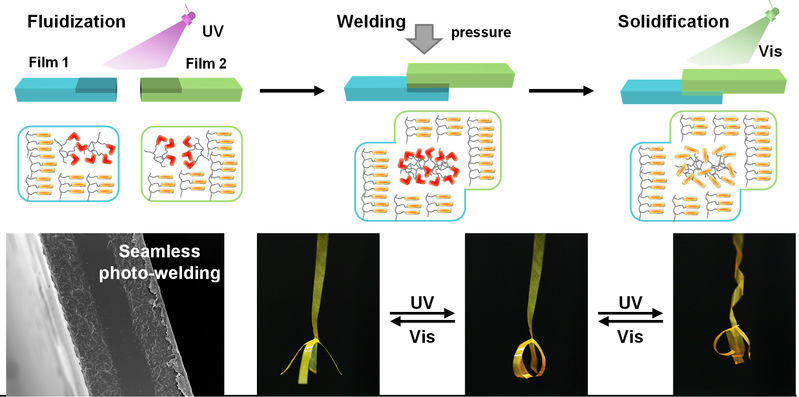Search
Title: Three-dimensional liquid crystal polymer actuators assembled by athermal photo-welding
Author: Yaoqing Feng, Jia Wei, Lang Qin*, Yanlei Yu*
Journal: Soft Matter, 2023, 19, 999-1007
Abstract:
Photodeformable liquid crystal polymers (LCPs) exhibit shape changes of different modes like bending, twisting, and oscillation, which depend on the orientation of liquid crystals. However, it is challenging to create a three-dimensional (3D) actuator with distinct actuation modes due to the difficulty of local orientation in a complex bulk architecture. Here we propose a strategy based on athermal photo-welding to integrate different orientations into a single flexible actuator by the photofluidization of azobenzene-containing linear LCPs. Stretch-induced uniaxial films are cut in different directions and subsequently welded via local photofluidization, during which the LCP transitions from a high-modulus glassy state to a rubbery state upon photoisomerization of azobenzene at room temperature. As a consequence, a cucumber vine-like structure with the opposite handedness and a lifting gripper are constructed by such a cut-and-weld process, demonstrating diverse deformation modes of winding, unwinding, and curling. This strategy provides an athermal process for the fabrication of seamless 3D flexible actuators without structural defects, which have potential applications in micromechanical systems, soft robotics, and artificial muscles.
Fulltext Link: https://pubs.rsc.org/en/content/articlelanding/2023/sm/d2sm01476a

Here, we used ring-opening metathesis polymerization (ROMP) to synthesize a series of liquid crystal polymers (LCPs) with different side chain mesogens. Moreover, 3D composite actuators with different orientations of liquid crystal mesogens were fabricated by cut-and-weld process. The realization of athermal light welding is derived from the photofluidization of LCP containing azobenzene group, in which the LCP transitions from a high-modulus glassy state to a rubbery state due to photoisomerization of azobenzene at room temperature. Taking advantage of this process, a cucumber vine-like structure with opposite handedness is produced using photo-welded LCP ribbons with different orientations upon light irradiation. In addition, a light-controlled lifting gripper is fabricated with LCP ribbons of different orientations. Notably, this approach can be applied to any polymers that exhibit the photofluidization, and it also allows for the integration of different materials without structural defects in the welded region.







